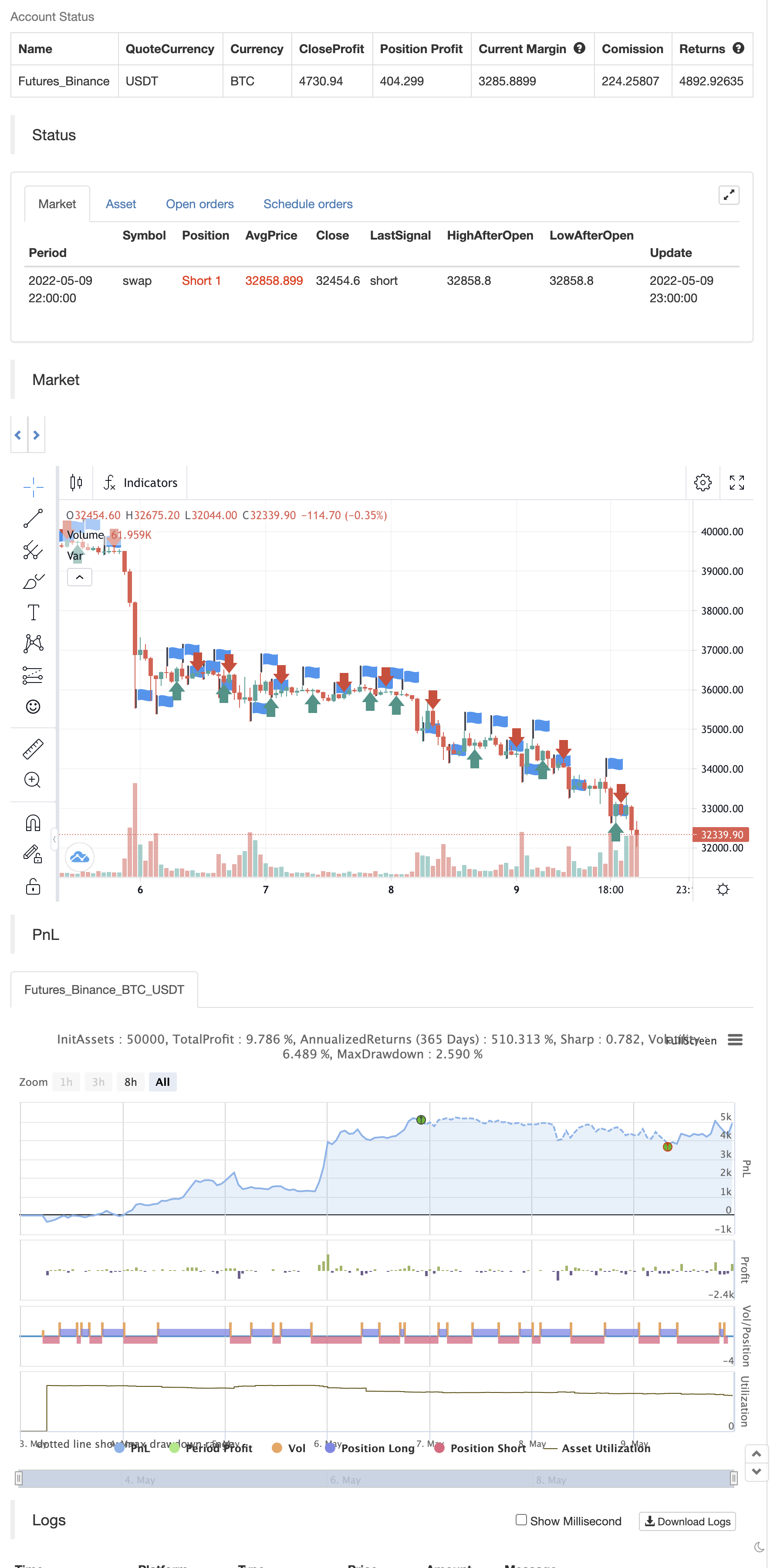Fractals plus petits (+ Transparence)
Auteur:ChaoZhang est là., Date: 2022-05-11 14h05:06Les étiquettes:Je suis désolée.
Fractals plus petits (+ Transparence)
Je trouve que les fractales sont super utiles, mais peuvent visuellement encombrer le graphique assez rapidement.
En tant que tels, ils sont comme des fractales réguliers, seulement plus petits (écriture pinsize.tinyau lieu de la valeur par défautsize.small).
En outre, vous pouvez définir un niveau de transparence à ces petits gars (par défaut est de 50%).
Des fractales simples, plus polis, et j'espère plus utiles pour ceux qui veulent un graphique plus propre.
test de retour

/*backtest
start: 2022-05-03 00:00:00
end: 2022-05-09 23:59:00
period: 1h
basePeriod: 15m
exchanges: [{"eid":"Futures_Binance","currency":"BTC_USDT"}]
*/
//@version=5
indicator("(Smaller) Williams Fractals", shorttitle="Tiny Fractals", format=format.price, precision=0, overlay=true)
// Define "n" as the number of periods and keep a minimum value of 2 for error handling.
n = input.int(title="Periods", defval=2, minval=2)
clr_trans = input.int(title="Fractal Transparency", defval=50)
// UpFractal
bool upflagDownFrontier = true
bool upflagUpFrontier0 = true
bool upflagUpFrontier1 = true
bool upflagUpFrontier2 = true
bool upflagUpFrontier3 = true
bool upflagUpFrontier4 = true
for i = 1 to n
upflagDownFrontier := upflagDownFrontier and (high[n-i] < high[n])
upflagUpFrontier0 := upflagUpFrontier0 and (high[n+i] < high[n])
upflagUpFrontier1 := upflagUpFrontier1 and (high[n+1] <= high[n] and high[n+i + 1] < high[n])
upflagUpFrontier2 := upflagUpFrontier2 and (high[n+1] <= high[n] and high[n+2] <= high[n] and high[n+i + 2] < high[n])
upflagUpFrontier3 := upflagUpFrontier3 and (high[n+1] <= high[n] and high[n+2] <= high[n] and high[n+3] <= high[n] and high[n+i + 3] < high[n])
upflagUpFrontier4 := upflagUpFrontier4 and (high[n+1] <= high[n] and high[n+2] <= high[n] and high[n+3] <= high[n] and high[n+4] <= high[n] and high[n+i + 4] < high[n])
flagUpFrontier = upflagUpFrontier0 or upflagUpFrontier1 or upflagUpFrontier2 or upflagUpFrontier3 or upflagUpFrontier4
upFractal = (upflagDownFrontier and flagUpFrontier)
// downFractal
bool downflagDownFrontier = true
bool downflagUpFrontier0 = true
bool downflagUpFrontier1 = true
bool downflagUpFrontier2 = true
bool downflagUpFrontier3 = true
bool downflagUpFrontier4 = true
for i = 1 to n
downflagDownFrontier := downflagDownFrontier and (low[n-i] > low[n])
downflagUpFrontier0 := downflagUpFrontier0 and (low[n+i] > low[n])
downflagUpFrontier1 := downflagUpFrontier1 and (low[n+1] >= low[n] and low[n+i + 1] > low[n])
downflagUpFrontier2 := downflagUpFrontier2 and (low[n+1] >= low[n] and low[n+2] >= low[n] and low[n+i + 2] > low[n])
downflagUpFrontier3 := downflagUpFrontier3 and (low[n+1] >= low[n] and low[n+2] >= low[n] and low[n+3] >= low[n] and low[n+i + 3] > low[n])
downflagUpFrontier4 := downflagUpFrontier4 and (low[n+1] >= low[n] and low[n+2] >= low[n] and low[n+3] >= low[n] and low[n+4] >= low[n] and low[n+i + 4] > low[n])
flagDownFrontier = downflagUpFrontier0 or downflagUpFrontier1 or downflagUpFrontier2 or downflagUpFrontier3 or downflagUpFrontier4
downFractal = (downflagDownFrontier and flagDownFrontier)
plotshape(downFractal, style=shape.triangledown, location=location.belowbar, offset=-n, color=color.new(#F44336,clr_trans), size = size.tiny)
plotshape(upFractal, style=shape.triangleup, location=location.abovebar, offset=-n, color=color.new(#009688,clr_trans), size = size.tiny)
if upFractal
strategy.entry("Enter Long", strategy.long)
else if downFractal
strategy.entry("Enter Short", strategy.short)
Relationnée
Plus de
- Les États membres
- 3EMA
- Blocs d'ordre pivot
- Les États membres doivent respecter les dispositions suivantes:
- Moyenne mobile EMA/SMA couleur
- Groupe MAHL
- 3 Supertrend ajouter dans ce seul script
- Indicateur de basse/haute oscillation avec confirmation du MACD et de l'EMA
- Le taux d'intérêt est le plus bas
- Jouer au cross
- Point d'entrée BB-RSI-ADX
- Hull-4ema
- Indicateur de ligne d'attaque d'angle
- La ligne KijunSen avec la croix
- AMACD - Divergence de convergence de toutes les moyennes mobiles
- MA HYBRID par RAJ
- Tendance au diamant
- Nik Stoch est là.
- le stock est supérieur à 200 ma
- RSI MTF et stratégie STOCH